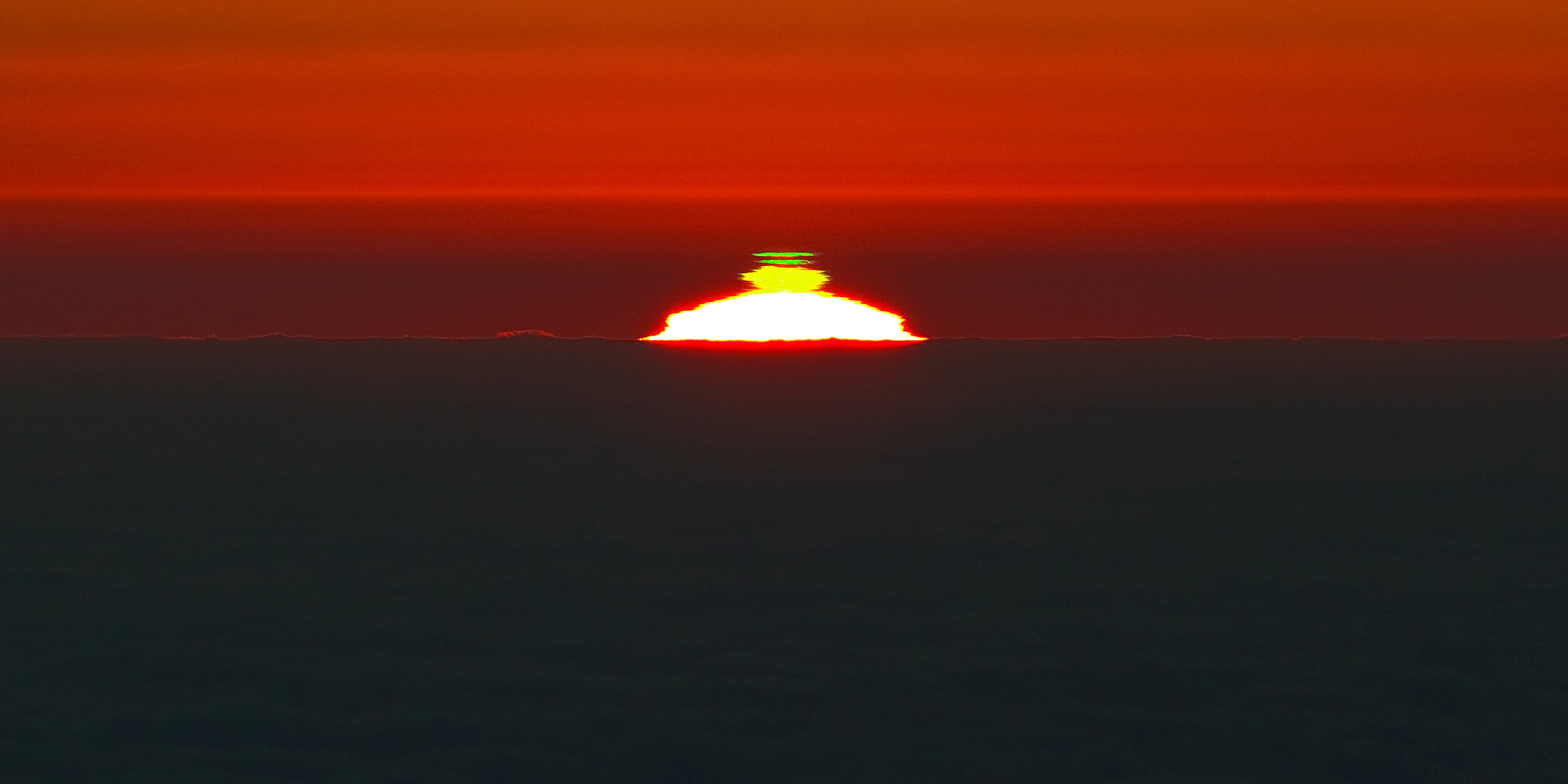Originally published 30 December 1985
For 20 years I have looked for the green flash. I have looked from mountain tops and from canyon rims. I have looked from the coasts of two continents. I have looked at sunrise and I have looked at sunset. I have not seen it.
The green flash is a momentary burst of color that is sometimes seen at the top edge of the Sun’s disk as it drops below the horizon at sunset, or as it appears above the horizon at dawn.
Modern interest in the green flash did not begin with scientific observations, but with a work of science fiction. Jules Verne’s Le Rayon Vert, published in 1882, described a long search for the mysterious ray.
My own long quest for the green flash began when I read an article on the subject in 1965 by the astronomer D. J. K. O’Connell of the Vatican Observatory. The effect described by O’Connell seemed so evanescent, so unexpected, so marvelous, that I have pursued it ever since. The green flash turned out to be grandly elusive; 20 years later I am still waiting and watching.
Retinal fatigue?
Before O’Connell’s research it was widely assumed that the green flash was a subjective phenomena or an optical illusion. Retinal fatigue was commonly held to be the “cause” of the flash. After looking into a brightly colored light our eyes become fatigued, and upon looking away we see the complimentary color; so, according to this theory, after looking for a while at the setting Sun, which is red, we tend to see the complimentary color, green, when the sun drops below the horizon. But retinal fatigue does not explain why the flash can precede the Sun at sunrise.
O’Connell’s work proved the subjective theories false. He succeeded in obtaining color photographs of the flash. The photographs were not easy to make. The band of color to be captured on film is exceeding narrow and fleeting. But the evidence of the photographs was indisputable. The green flash is not an artifact of the eye. In photograph after photograph, the Sun’s red disk is capped with a strip of emerald green.
The green flash can only be seen if the horizon is sharply defined and the sky is free from haze, conditions most commonly encountered in the tropics, on coasts, in high mountains, or in deserts. I have friends who often saw the green flash from the deck of an oil tanker in equatorial waters.
O’Connell notes that Egypt offers exceptionally favorable circumstances for observing the flash, and he points out that there is some archeological evidence that the ancient Egyptians were familiar with the phenomena. According to O’Connell, there is a stone pillar dating from 2000 B.C. that shows the rising sun colored blue above and green below. The Egyptians seem to have believed that the sun is green during its nocturnal passage beneath the Earth, a lovely idea that may have derived from observations of the green flash at both sunset and sunrise.
The cause of the green flash has now been carefully established. As the Sun rises or sets, its light strikes the Earth’s atmosphere at an oblique angle and passes through a great thickness of air. The atmosphere causes the light rays to bend or refract, in the same way that a stick appears bent that is partly submerged in water at an angle. The degree of bending depends upon the color of the light; violet rays are deflected most, red rays least.
Rainbow of colors
As with a prism, this disperses the Sun’s colored rays into a rainbow. When the Sun sets, its colors should disappear over the horizon one by one — red first, violet last — depending upon the degree of bending, as the rainbow passes across the observer. But the orange and yellow rays in the light of the setting Sun are absorbed by water vapor, oxygen, and ozone in the atmosphere. The blue and violet rays are scattered out of the path of the light by bouncing off molecules of air. Other than red, the color least affected by passage through the atmosphere is green, and that is what, briefly, the observer sees.
In producing the green flash, nature uses almost every gimmick in its optical bag of tricks — refraction, dispersion, absorption, and scattering. It is a dazzling production, a bit of natural wizardry, a marvel of optical legerdemain.
In a way, I am pleased that my search for the green flash has been unsuccessful. Some things in nature should remain elusive. “What makes the desert beautiful,” said Antoine de Saint-Exupéry’s Little Prince to his pilot, “is that somewhere it hides a well.” The green flash is my hidden well.
But I will go on looking. After all, what activity could be more pleasurable than standing on a rocky coast or a mountain peak at sunrise or sunset, holding my breath with a world that is expectant and still, waiting to be stained for an instant green by a curious quirk of light and air.
In the years since this essay was first written, Chet personally witnessed the elusive green flash many times from a favorite beach in the Bahamas. ‑Ed.



